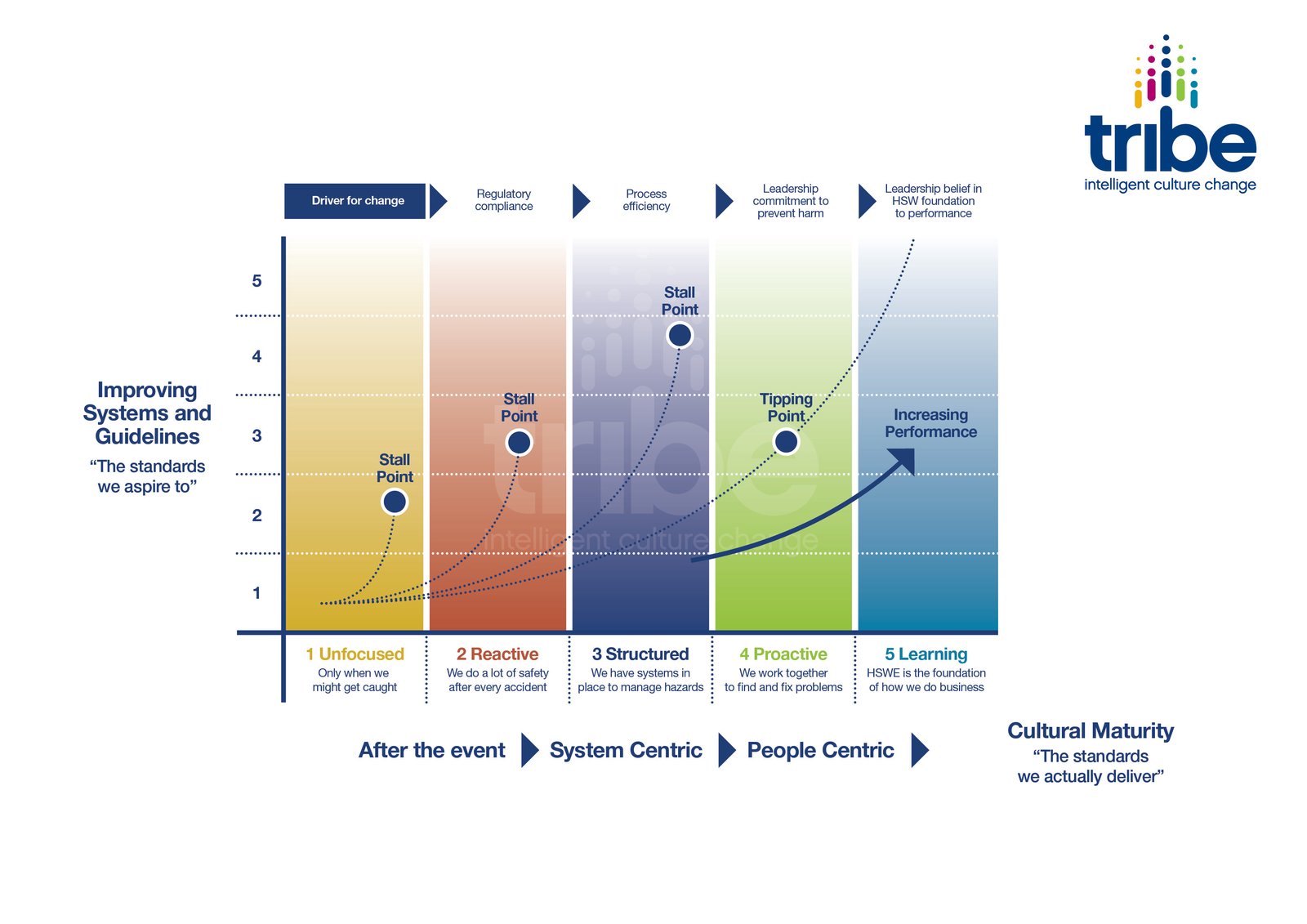
The culture change journey: What does it take to become a ‘level four’ culture?
Tribe Culture Change’s lead consultant and behavioural psychologist, Sarah Prince, reveals in a recent article on SHP Online how she works with health, safety and wellbeing leaders on culture change programmes and typical issues as you journey through the culture change curve.

At Tribe, we work with organisations to help them journey through the cultural maturity curve. The curve shows different levels of cultural maturity – from one to five – each showing a distinct phase in an organisation’s approach to health, safety and wellbeing.
At levels one and two, the approach to health, safety and wellbeing is unfocused and more reactive. At the other end of the scale is level five – when health, safety and wellbeing underpins your organisational DNA.
As a behavioural psychologist, I find that a lot of the work I do with Tribe Culture Change is when clients find themselves at a level two or three.
At this level, companies are admitting they may inadvertently be putting people at risk because they don't have the right processes and procedures in place. And even if they do have them in place, they’re unsure about what else they could be doing. They want to ensure better health, safety and wellbeing for their workforce but don't know how.
But having systems and processes in place isn’t enough. These systems and processes need to be robust and well-understood by the workforce.
The transition to level four
So while level three is about understanding the current processes and having good leadership behaviours visible in the workplace, level four focuses on how everyone across all levels of the business can be involved to ensure long-lasting change.
We understand that incidents occur because of a whole variety of reasons. It can be a lack of training, or pressure of targets. It can also be the tools and equipment, or simply the processes and systems no longer work.
Any of these factors may cause someone to behave in a certain way, but these behaviours need to be understood and acted upon to create change.
The shift to level four involves a deeper understanding of each different workplace and encouraging collaborative problem-solving.
At this level, it’s so important for the workforce to feel heard and valued by leadership so we run focus groups and surveys to understand everyone's perspectives.
The findings of these research pieces are vital in understanding issues facing an organisation.
We may uncover that leaders’ collective view of themselves is they’re great and doing a fantastic job. But the workforce’s view of leadership may be less complimentary. It’s then a case of working out the disparity in opinion. It’s about understanding the missing pieces between the leadership team and the workforce.
Leadership engagement
Consistency in messaging and behaviour from the top down reinforces the importance of health, safety and wellbeing and helps embed it into the organisational fabric. But a leadership team's resistance to change can be the biggest hurdle.
Leadership engagement is the most important piece to go from level three to level four.
Leaders don’t always realise they need to actively participate in the transformation process. We find that often, organisations want to start a culture change programme with the workforce. But when leadership show the right behaviours and say the right things, the workforce will feel empowered to do the same.
Gentle coaching methods can really help to facilitate change and encourage leaders to understand the impact of their behaviour. And then it’s about creating small, actionable steps that leaders can integrate into their daily routines.
Leaders can become caught in reacting to day-to-day situations and driven by goals and targets but I do a lot of reflective work to allow them to stop and think. What went well within a conversation? What could be done differently next time?
It’s about getting a consistent practice in place to help change a mindset and move from one which is very rigid to one which is a little bit more flexible.
I like to say that you wouldn't ask a caveman to go into space and become a spaceman. It’s about incremental steps and consistent practice. Behaviour doesn't just happen because you tell somebody to behave a certain way. It comes through consistent practice.
In practice
As part of my work with Tribe, I’ve been working with 40 senior leaders at a national construction company. I help them reflect upon how they discuss health, safety and wellbeing with their teams, and particularly how the values of the organisation can impact on how people think and behave.
We uncovered that the message they thought they were sharing wasn’t being received so they’re now being more explicit in their communications with the wider workforce.
As a result, many of leaders have started to talk about health, safety and wellbeing much more openly and directly, and after a few months, they noticed their teams were doing the same.
It’s the small, everyday changes which make the biggest impact.
Four key strategies for transition to a level four culture
- Leadership engagement: The transformation begins with the leadership team. Leadership must consistently demonstrate their commitment to health, safety and wellbeing, which encourages the entire organisation to follow.
- Effective communication: One of the significant challenges at this stage is bridging the gap between leadership and the workforce. Clear, consistent messaging that resonates with all levels of the organisation is vital. This includes using creative communication strategies such as huddle cards and espresso moments to reinforce messages regularly.
- Collective problem-solving: Moving to level four requires an inclusive approach where everyone contributes to identifying and solving issues. This means involving middle management and frontline workers in discussions about health, safety and wellbeing practices and encouraging them to share their insights and experiences.
- Empowerment and autonomy: Empowering workers to take ownership of health, safety and wellbeing practices is crucial. This involves giving them the autonomy to make decisions in their daily tasks and recognising their contributions to fostering a healthier, safer and happier workplace.
About Sarah Prince
Lead Consultant
Sarah’s main passion lies in looking at culture through a holistic lens, understanding what drives behaviour and using psychological models of behaviour to help organisations improve their safety culture. She’s led safety culture change programmes for more than a decade and holds an MSc in the Psychology of Behaviour Change in Health and Safety.
Specialisms: Leadership and employee engagement, Behaviour change psychology
Industry experience Construction, Manufacturing, Oil and Gas, Quarrying



